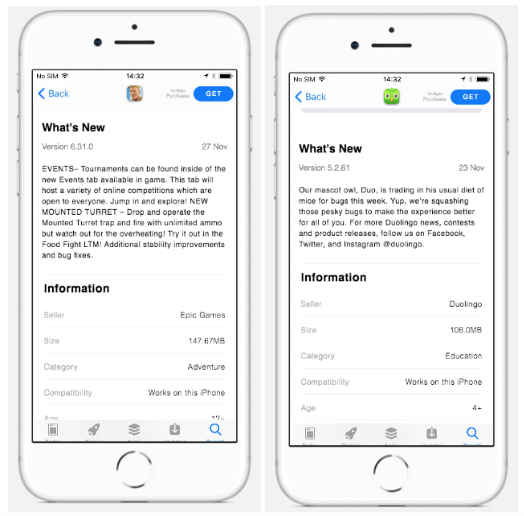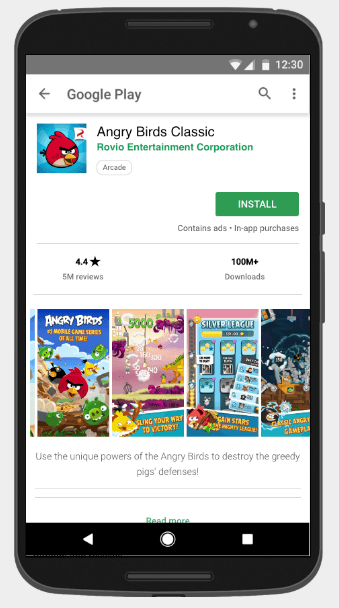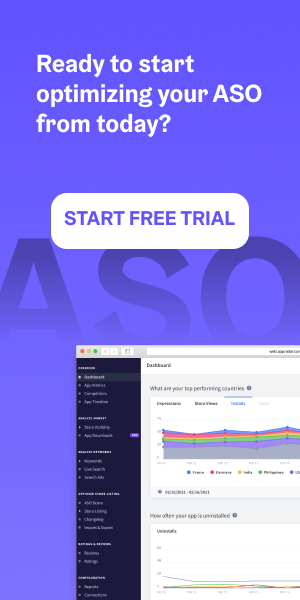Today we are going to see the phenomenon of reinstalled apps, covering the main reasons why they happen and how can they affect ASO. Keep reading!
Table of Contents
What are App ReInstalls?
In many occasions, we install an app, give it a ride for a single purpose, and then get rid of it. Later, maybe in a few months or in a year, we install it again. So that’s a reinstallation: the act of installing an app that you have already downloaded before at some point.
It may be something quotidian, but truth is that a massive fraction of installs are actually reinstalls. In fact, a recent study carried out by Tune shows that 42% of all installs are re-downloads. And here’s some interesting data about it, always according to Tune’s report:
- Reinstall percentage can go up to 75%, depending on the category
- 98% of users have reinstalled an app at some point
- Search drives 65% of all redownload behavior
- Games are reinstalled 55% more frequently than apps
- Large brands own 70% of the most reinstalled apps on the App Store
These are some insights to think about, huh? Let’s dive right into the reasons why this phenomenon happens.
Reasons To ReInstall
A frequent reason to uninstall an app to reinstall it later is insufficient memory in the smartphone. Let’s say you install an application to edit images, and after finishing what you had in mind you uninstall it because it takes valuable memory of your device. But that’s not all of it.
There are certain apps whose life cycle depends on seasonality. For example, there might come a time when a user needs to find a roommate or a new flat, and therefore install several apps to do so. Once its purpose is fulfilled, the app becomes useless and it goes away. Maybe in a year or two, you need it again and reinstall it. And that’s the point, there are lots of apps that are seasonally and you get them because you need them for a certain period of time. This becomes usual for applications that have been available on the market for a long time.
It’s also frequent with mobile games, as they are trending during a period of time and everybody plays them. After a certain time, users get rid of them and reinstall them when they add new features or they just become trendy again.
Here are some more insights about reasons to reinstall apps or games that Tune’s report showed:
- 18% of users delete an application because it was buggy, just to re-download it later to force a reset and solve the problem
- 13% delete that they later found out they needed… And therefore redownloaded it
- 6% delete by mistake and had to reinstall it
- 1% say there was a sale that required purchase via app, so they reinstalled it
Tracking Mobile Apps & Games ReInstalls
It’s important to keep track of installs, uninstalls and re-downloads, especially when we know everything they entail. A user deleting our app doesn’t mean that he will never come back, so we can work on user retention and engagement. If we know when users have uninstalled and reinstalled, we can know our churn and evaluate the app’s lifecycle.
However, these values might be difficult to track because of the discrepancy between Analytics Platforms (Google Play Console, iTunes Connect or Google Analytics) and Mobile Attribution Platforms, also known as trackers. This is completely normal, though, so there’s no need to worry. It is important to know that Attribution Platforms like AppsFlyer or Adjust consider an install when the user has downloaded and opened an app. If the user doesn’t interact with it, it doesn’t count.
For our matter at hand, the stores can show either unique 2 installs for the same user, as it happens on Google Play Console, or unique users, which is a little bit more accurate. Either way, we don’t get the concept “reinstall” per se. A tracker like AppsFlyer doesn’t attribute re-installs and its information is closer to the unique visitor concept.
Improving Reinstall Rate with ASO
The high percentage of reinstalls give us some hope, it means that although users delete the app that doesn’t mean they won’t install it again – in fact, they probably will if we do things right. Exactly, we need to keep working on ASO to drive users to the store listing, especially users that have already downloaded our product before.
Users can give you another chance if they see that you have been working on it, for example: fixing bugs that were annoying, adding new features, etc. It’s also possible that users find the app again because you have been working hard on ASO and, therefore, your app has increased its visibility on the stores.
Let’s see some tips on how to attract users (especially the ones that have already had our app before) and convince them to download.
“What’s New” Section
On Apple App Store there’s a “what’s new” section that comes in handy to attract users. On Google Play it’s usual to see it in the Long Description, too. Either way, it’s an interesting and useful approach and can be a great conversion factor.

There are many apps that don’t take many advantages of it. They write vague descriptions sharing that they are constantly updating and fixing, which is fine as it shows commitment, but it doesn’t include meaningful information or any specifications. This approach is not really advisable, as it would work better to add concrete information.
A good approach can be to highlight specific bug fixes. By sharing that information, users can see that the app has been worked and there may be fixed bugs that originally caused uninstalls. This push could be key to get users to give the app a second chance. However, try to share valuable information, as the risk of that approach is that showing minimal technical changes can be meaningless for returning visitors.
Our tip here is to give the text a personal touch and make it not too technical. Be original and communicate main fixes, give valuable information on new features of the app… Basically, show that if there’s a problem you solve it quickly and efficiently and call out bug fixes in a simple way. This can be extremely useful to re-engage with users!
Visual Assets
Another strategy can be to work on the creative designs to show that there has been a major upgrade, as visual information is more appealing than text. Consider updating your screenshots and videos to add valuable information that could attract a returning user.

Apple Search Ads
We’ve seen that it’s difficult to track exactly the number of reinstalls, but there is a good way to target users that have had our app at some point and then uninstalled it. Apple Search Ads allows running campaigns targeting users that once downloaded our app but now they don’t. We can’t get the data of who have uninstalled, but it is possible to target them in order to re-engage and try to convince them to download (and use) it again.
Here you can find our ASA guide.
To Wrap It Up – App ReInstalls / Re-Downloads
It’s clear now that uninstalls aren’t the end of the world for app marketers, as there are many ways to improve and somehow make users reinstall to give it another chance. It can also be useful to engage using push notifications or emails, the point is to stay connected without being too annoying.
Be as it may, it’s proven that constant work on ASO will drive more traffic to the app, and even traffic that had the app at some point and uninstalled it for whatever reason. Isn’t that amazing?
If you liked it or have any more insights about the topic, let us know in the comments!
And as usual, sharing is caring 🙂




